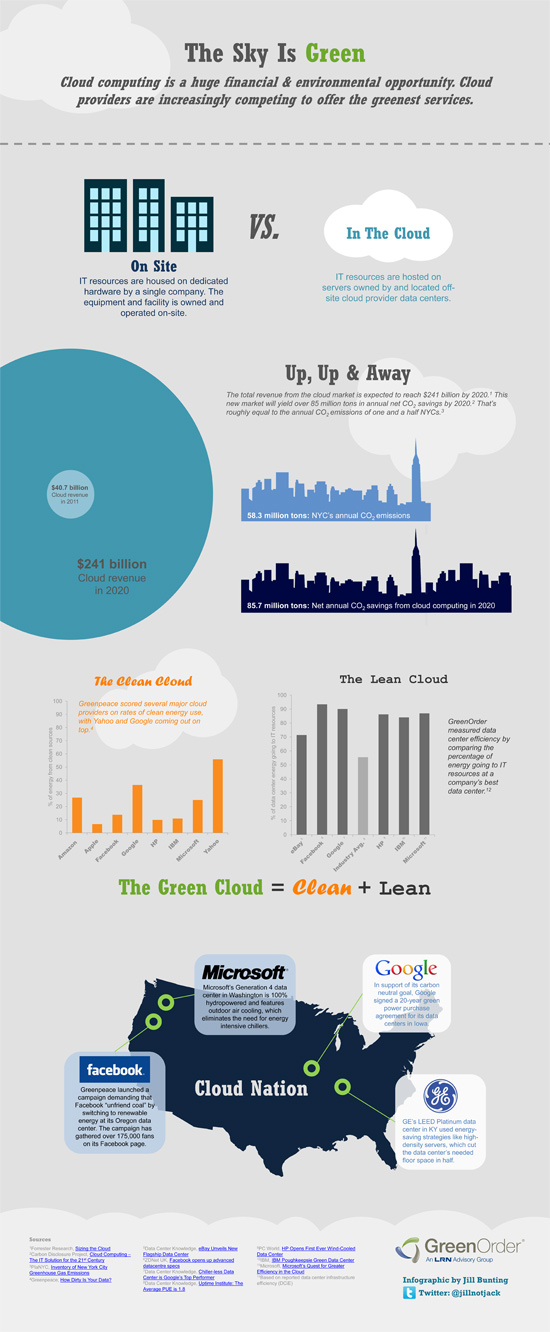Use of Renewable Energy Resources for Cloud Computing by IT companies

The global information technology brands such as Microsoft, Apple, Google, Yahoo, Amazon and Facebook are in a competition to provide greenest cloud computing by changing the ways of listening to music, sharing images, watching movies or TV, communicating and working. Because of excessive scale and enlargement of assets, the cloud computing society is growing rapidly and is estimated to develop up to 50 times its existing amount by the year 2020. According to an estimate, half of a trillion dollars will be fed by next year for enhancing the cloud computing and at the same time increasing the people’s longing to have even better access to information via mobile devices like tablets and phones.
Companies like Apple, Amazon and Microsoft are developing quickly without showing any worries about the electrical resources they are using. All these 3 ventures are trying to run their clouds with unclean force. On the other hand, Yahoo and Google use the renewable energy resources to enhance their clouds. Both these companies also support the idea of using renewable energy and try to produce funds for it. Facebook has almost 800 million users in the world and it promises to run its podium by the use of renewable energy resources and construct the main datacenter in Sweden. This datacenter will be completely dependent on renewable sources for its energy requirements.
The turning of datacenter of all the biggest IT companies of the world to renewable energy resources can play a very important role to overcome the world’s energy demand. If all these companies continue expanding their datacenters and communities without turning to renewable resources, they will never cut short their burden on the non renewable resources because of their cost effectiveness. All these companies must also report their carbon footprints according to the Carbon Utilization Effectiveness Standards. Akamai is that IT company which regularly reports its carbon footprint.
Most of the IT companies around the world claim their clouds to be eco friendly but they do not have proper experts and equipment for environmental impact assessment and thus the data provided by them is not up to standard. Moreover these IT bodies are also short of clearness and precision. For organizing the energy efficient hardware and software plans, open source distribution must be done ensuring team work of IT companies which can also improve their systems. By this, these companies may also be able to harmonize their working. Most cloud computing societies are keen to practically turn to renewable sources to fulfill their energy demands and if all these companies do so, they can ensure a better energy future of the world and may minimize the future energy crisis.
As the cloud computing trend is growing, their datacenters are improved and getting better and bigger and so their energy demands are. Most cloud computing communities have cut short their use of energy. But with this entire enhancement, the betterment of cloud computing companies is also enhancing the demand of cloud based goods which in turn enhance the requirement of power for their datacenters. They, thus, can produce much more greenhouse gases emissions than any other source so they need to sustain and verify their greenhouse global emissions by replacing their dirty sources of energy to renewable ones.
Yahoo, Google, Akamai and Salesforce are those major IT companies which are ready to show their carbon footprints related to their clouds. Whereas, some IT companies also use the power in an inapt way but show their energy consumption by the use of Power Usage Effectiveness. In other words, these companies are hiding their real functioning, rate construction and communication methods from their contemporary competitor companies. They just reveal their Power Usage Effectiveness but do not show the actual data of their footprints which in turn is harmful to the planet earth in the long run.





